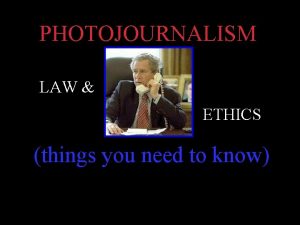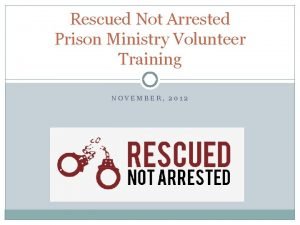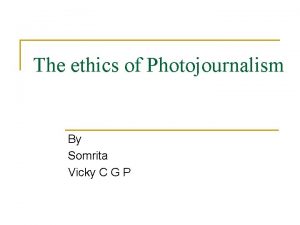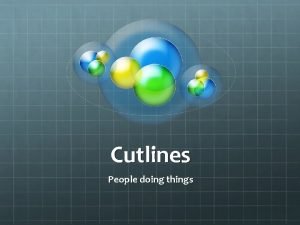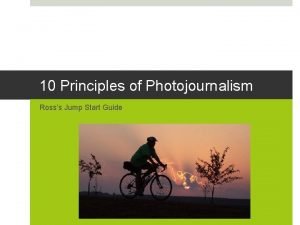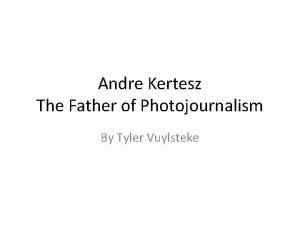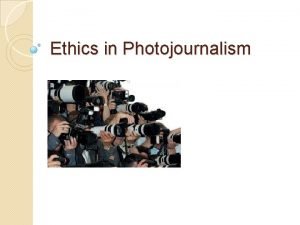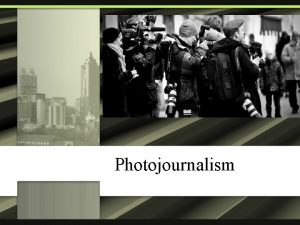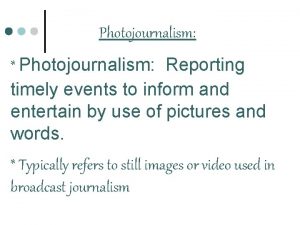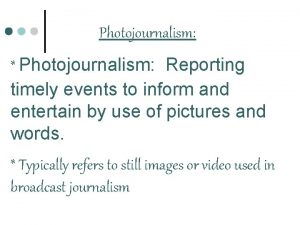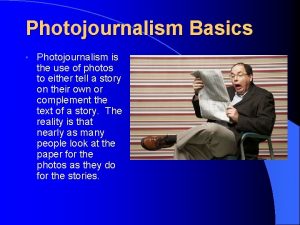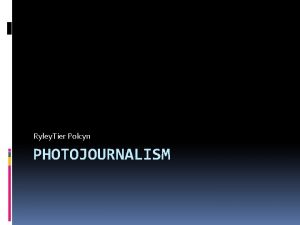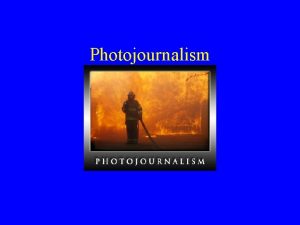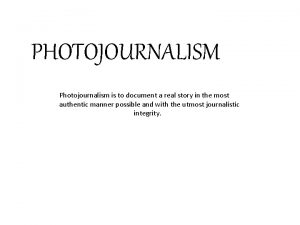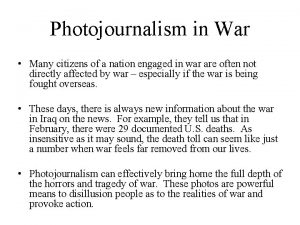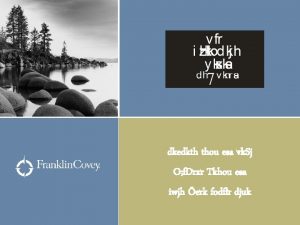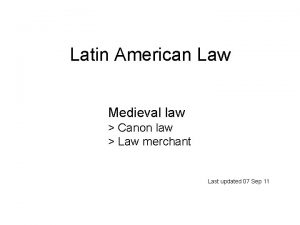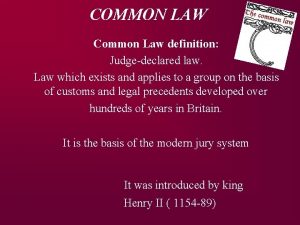THE LAW and Photojournalism GETTING ARRESTED Many of























- Slides: 23

THE LAW and Photojournalism

GETTING ARRESTED • Many of us have read stories of photojournalists getting arrested for trespassing, interfering with police, or somehow becoming involved in a protest gone violent. • In the United States, however, the law allows fairly wide latitude. • News photographer usuallly have the legal right to take photos in a public place—whether or not they do it ethically. • Note ethics and law are two separate things!

PRIVACY AND PHOTOJOURNALISM United States law does, however, give subjects of photography some rights as it relates to areas of privacy and security. • Trespassing. This means being on private property without authorization. • Photojournalists need to be careful about going under fences, through doors and generally into areas likely designated as private. • If a facility is open to the public, a photojournalist can go into it “for its designated purpose. ” • That means you can go into a shopping mall, hospital, school, restaurant or store. BUT in principle you can’t take pictures—because that’s not its “designated purpose. ” • You must seek out permission if you plan to use them in mass media.

PRIVACY AND LAW ENFORCEMENT • Trespassing laws apply even if a photojournalist accompanies law enforcement. • For example, you may have permission to ride along with a police “party patrol” going to arrest minors for underage drinking. • But if you take photos of people drinking on private property, you risk a lawsuit. • Allowing photojournalists to accompany law enforcement has become less common as the lawsuit risk has increased.

GOVERNMENT PLACES AND OFFICIALS • Generally photojournalists are attracted to the same events that attract law enforcement: accidents, fires, arrests, riots, disasters. • But law enforcement people aren’t generally enthusiastic about having photojournalists at these events. • One common approach is to arrest the photojournalist temporarily, drop charges a few days later, when it’s too late to cover the story. • If you have a good relationship with law enforcement, and approach an event with tact and persuasion, you may get a better outcome.

LAW ENFORCEMENT • Some photojournalists quickly try to get to an event before law enforcement, knowing they’ll be kicked out as soon as police arrive. • This leads to those lamentable episodes of photojournalists insensitively snapping away after an accident or disaster, and speeding after ambulances or fire trucks. • But photojournalists know they must come back with the pictures, or risk anger of the editor. • And they also know their readers do actually look at those pictures.

YOUR RIGHTS TO THE SIDEWALK • Legally a photojournalist has the right to stand in a public place, say, the public sidewalk, and take photos. • But the police can arrest you anyway, on a charge of “disorderly conduct, ” if they don’t want you to take pictures. • In other words, they can keep you away from an event for pretty much any reason they want. • Note: laws that apply to photojournalists also apply to the public with smartphones!

PUBLIC BUILDINGS • Regarding federally owned buildings, generally you are free to photograph in the pubic areas, unless told it’s specifically off limits. • The Postal Service allows photography in lobbies and public areas. • Schools depend on state law. If pupils are under 18, it’s a tricky area. • Even if you stand on a public sidewalk photographing children, you may be legally entitled, but you may be challenged by parents or school officials. • The public spaces within universities generally are legally open to photojournalists. • The classrooms, residence halls and labs generally aren’t.

COURTROOMS • Photography in the courtroom has been a matter of extensive debate in the United States. • Currently it’s left up to the states or judges to decide. • It’s closely controlled in most instances. You can’t just walk around taking pictures.

PICTURES ON THE STREETS • On the streets, the sidewalks, the parks and other public places, you usually have the legal right to take pictures. • These are the areas legally safest for photojournalism. • If you are doing something on the public streets and related areas, by U. S. law you are accepting the possibility of being photographed.

THE STREETS AND ETHICS • Even though a photojournalist is legally permitted to take pictures in public areas, is he or she ethically permitted? • This is one reason editors require photographers to get identification: it implies the subject is all right with being photographed. • Editors don’t want to hear from irate people complaining of being photographed, even if it is legal. • What is the person is an accident victim, or in an embarrassing situation? Usually photographing them in public still is considered legal, though it may be unethical.

INVASION OF PRIVACY Trespassing is one area of the law applicable to photojournalism. So is invasion of privacy. Privacy law includes these areas most applicable to photojournalism: • Appropriation of an image for another use. Photojournalists have fairly wide legal ability to use an image in a news publication. But they can’t use that image for another purpose. For example, they can’t use it in an advertisement or promotional campaign. They also can’t Photoshop several images together to produce a composite without permission of the subject.

MODEL RELEASE • If a photographer wants to use an image for promotion or advertising, he or she needs written permission. • This written permission usually is a standard form called a model release. • The more specifically a model release describes possible uses for an image, the less it protects the photographer, but the better it protects for that specific usage. • Children (under 18) can’t legally sign a model release. It must be signed by parent or guardian.

A TYPICAL MODEL RELEASE • Here is a typical short model release (From New York Institute of Photography): Model Release In exchange for consideration received, I hereby give permission to ______ to use my name and photographic likeness in all forms and media for advertising, trade, and any other lawful purposes. Print Name: Signature: Date: If model is under 18: I, _____, am the parent/legal guardian of the individual named above, I have read this release and approve of its terms. Print Name: Signature: Date:

PRIVACY AND INTRUSION • Intrusion involves invasion of privacy when a person reasonably believed the activity to be private. • Obviously, if you are taking photos on private property, you are intruding on privacy. • Sometimes, however, it’s less clear cut. If, for instance, you are taking photos of an accident from the sidewalk, you are legally protected. • If, however, you climb into an ambulance to take more pictures, you may be intruding on privacy—and may be trespassing.

ZOOMING INTRUSIONS • You may have a telephoto or zoom lens so long you can easily take pictures of people in their dorm rooms. • Doing so, however, is an invasion of privacy, even if you are standing on the sidewalk. • The principle is this: you probably can legally photograph someone from a public place if their activities can easily be observed by the average passer-by. • If, however, you need a telephoto lens to observe that activity, it’s intrusion.

PRIVATE CITIZENS AND PUBLIC OFFICIALS • Public officials and public figures surrender quite a bit of their rights to privacy. • Generally it’s presumed that the person gave up his right to privacy on deciding to become a public figure. • This is true not only for elected officials, but for celebrities. • Celebrities in America will seldom win a lawsuit involving right to privacy.

SNEAKING AROUND • Photojournalists have on occasion done exposés of unethical or illegal practices at workplaces by disguising themselves and surreptitiously taking pictures. • The shame of child labor in early factories was documented using this technique. • It may, however, subject the photographer to an intrusion lawsuit, even if the activity photographed was unethical or illegal.

PRIVATE FACTS • You may be open to a lawsuit if you disclose private facts that have nothing to do with any news value, and may be highly offensive to the average person. • This is true even if in a public place. Example: A photojournalist took a picture of a woman leaving a carnival funhouse. A hidden jet of compressed air fluffed her skirt up. The published photograph was entertaining to all—except the subject, who successfully sued. Note that even if the photographer had gotten her name, implying permission to publish, she still could later sue—because no written model release was obtained.

FALSE LIGHT • The job of photojournalists is non-fiction photography. That is to report the truth. • But some photojournalists are not ethical. If they choose to photograph someone with “reckless disregard” to the truth, they may face a lawsuit. • You may legally photograph an accident victim. If you later use that photo to illustrate an article on the carelessness of pedestrians, however, you may be held in “reckless disregard. ” • This was an actual court case.

LIBEL For photojournalism, it’s usually a matter of falsely depicting someone, such as • Using the stacking ability of a telephoto to suggest false relationships. • Capturing a moment out of context, without a cutline to explain. This is a legal justification for always using cutlines. • Obviously manipulating with Photoshop, say, by putting someone’s head on someone else’s body. • It is an interesting side note that film-based photography is often still required for law enforcement investigation, as it is harder to falsify truth.

GENERAL TIPS TO AVOID LEGAL TROUBLE • Be nice and tactful. • Taking pictures on public property is okay, but don’t use them for advertising. • Pointing your telephoto lens to activities on private property is risky. • Get IDs to help protect yourself, even if they may have no legal value.

MORE TIPS • Taking people doing things in public places is usually okay, as long as they’re doing something related to their public functions. • If an audience can’t take pictures at a concert, you can’t either, without express permission. • Photographing military property without permission is illegal. • Crossing police lines is illegal, even if you think they’re unfair. • You must have a signed model release to use a photo for promotion, even if it’s only a house ad, that is, a promotion to increase readership.
 Rules of photojournalism
Rules of photojournalism Getting ahead
Getting ahead Newton's first law and second law and third law
Newton's first law and second law and third law Newton's first law
Newton's first law Why is the dentist who didn't pull elie's tooth arrested?
Why is the dentist who didn't pull elie's tooth arrested? Roger munchian
Roger munchian Act 2 of the crucible
Act 2 of the crucible Tiberiu popa arrested
Tiberiu popa arrested Republic of fredonia
Republic of fredonia Who was arrested today
Who was arrested today General manuel mier y teran
General manuel mier y teran Kevin carter
Kevin carter Composition refers to
Composition refers to History of photojournalism
History of photojournalism Cutlines examples
Cutlines examples Principles of photojournalism
Principles of photojournalism Photojournalism rules
Photojournalism rules Photojournalism job
Photojournalism job Modern photojournalism
Modern photojournalism Photojournalism jobs
Photojournalism jobs Tyler andre nude
Tyler andre nude What is photojournalism
What is photojournalism V=k/p
V=k/p Avogadro's law constants
Avogadro's law constants
